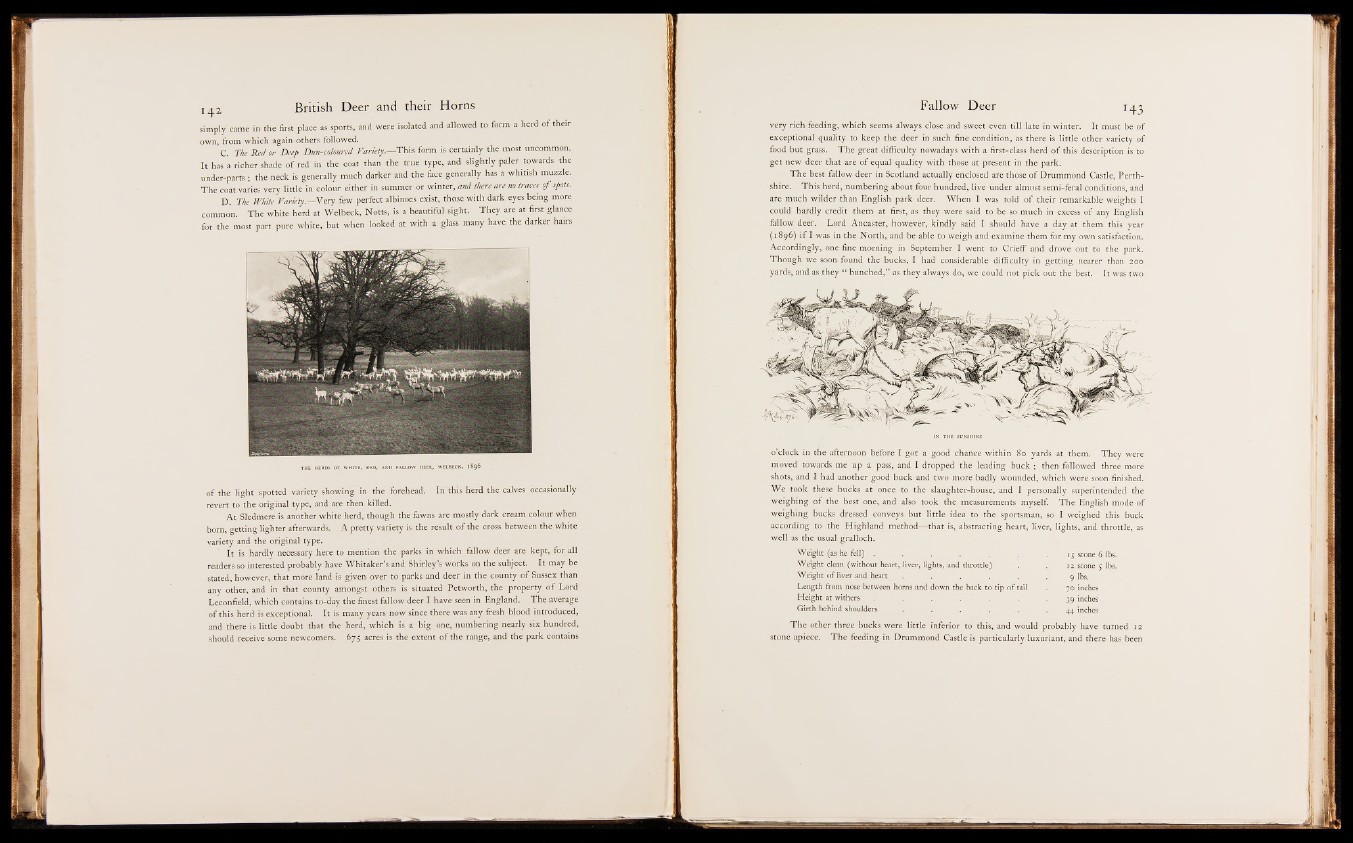
simply' came in the first place as sports, and were isolated^and allowed to form a herd- of their
own, from which again others followed.
C. The Red or Deep Dun-coloured Variety.— This form is certainly the most uncommon.
It has a richer shade o f red in the coat than the true type, and slightly paler towards the
under-parts ; the neck is generally much darker and the face generally has a whitish muzzle.
The coat varies very little in colour either in summer or winter, and there are no tra cesof spots;,;
D. The White Variety.— Very few perfect albinoes exist, those with dark eyes:ll|ing more
common. The white herd at Welbeck, N o t f l f c * beautiful sight. They are at first glance
for the most part pure white, but when looked at with a glass many have the darker hairs
THE HERDS OF WHITE, RED, AND FALLOW DEER, WELBECK, 1896
of the light spotted variety showing in the forehead. In this herd the calves occasionally
revert to the original type, and are then killed.
At Sledmere is another white herd, though the fawns are mostly dark cream colour when
born, getting lighter afterwards. A pretty variety is the result o f the cross between the white
variety and the original type.
' It is hardly necessary here to mention the parks in which fallow deer are kept, for all
readers so interested probably have Whitaker’s and Shirley’s works on the subject. It may be
stated, however, that more land is given over to parks and deer in the county o f Sussex than
any other, and in that county amongst others is situated Petworth, the property o f Lord
Leconfield, which contains to-day the finest fallow deer I have seen in England. The average
o f this herd is exceptional. It is many years now since there was any fresh blood introduced,
and there is little doubt that the herd, which is a big one, numbering nearly six hundred,
should receive some newcomers. 675 acres is the extent o f the range, and the park contains
very rich feeding, which seems always close and sweet even till late in winter. It must be o f
exceptional quality to keep the deer in such fine condition, as there is little other variety of
food but grass. T h e great difficulty nowadays with a first-class herd o f this description is to
get new deer that are o f equal quality with those at present in the park.
The best fallow deer in Scotland actually enclosed are those o f Drummond Castle, Perthshire.
This herd, numbering about four hundred, live under almost semi-feral conditions, and
are much wilder than English park deer. When I was told o f their remarkable weights I
could hardly credit them at first, as they were said to be-so much in excess o f any English
fallow deer. Lord Ancaster, however, kindly said I should have a day at them this year
(1896) i f I was in the North, and be able to weigh and examine them for my own satisfaction.
Accordingly, one fine morning in September I went to Crieff and drove out to the park.
Though we soon found the bucks, I had considerable difficulty in getting nearer than 200
yards, and as they “ bunched,” as they always do, we could not pick out the best. It was two
-o’clock in the afternoon before I got a good chance within 80 yards at them. They were
moved towards me up a pass, and I dropped the leading buck ; then followed three more
shots, and I had another good buck and two more badly wounded, which were soon finished.
We took these bucks at once to the slaughter-house, and I personally superintended the
weighing o f the best one, and also took the measurements myself. The English mode of
weighing bucks dressed conveys but little idea to the sportsman, so I weighed this buck
according to the Highland method— that is, abstracting heart, liver, lights, and throttle, as
well as the usual gralloch.
Weight (as he fell) . . . . . . . 15 stone 6 lbs.
Weight clean (without heart, liver, lights, and throttle) . . 12 stone 5 lbs.
Weight of liver and heart . ' . . . . 9 lbs.
Length from nose between horns and down the back to tip of tail . 70 inches
Height at withers . . . . . . - 3 9 inches
Girth behind shoulders . . . . 4 4 inches
The other three bucks were little inferior to this, and would probably have turned 12
stone apiece. The feeding in Drummond Castle is particularly luxuriant, and there- has been